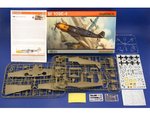- Thread starter
- #21
Airframes
Benevolens Magister
Sounds good, and the old Monogram C47 isn't obsolete! It's still a good kit, and a darned site cheaper than the over-priced, inaccurate Trumpeter example! I've been wanting to get one for some time (now under the Revell label), to build as either a WW2 para-dropping kite, or maybe a post war RAF Dakota, in bare metal, silver and white, with the blue cheat line, or a 1950's civilian airliner, or a........

